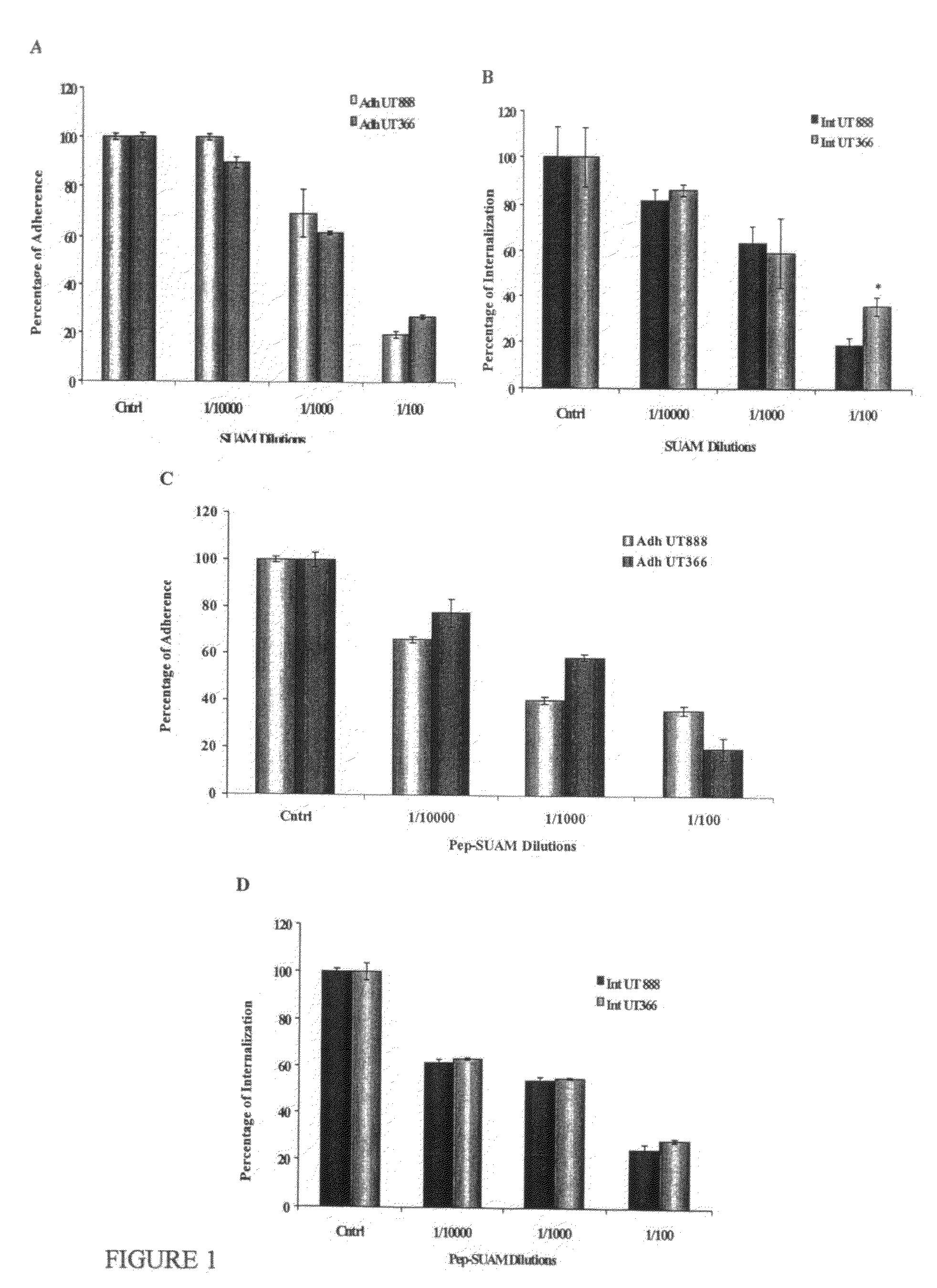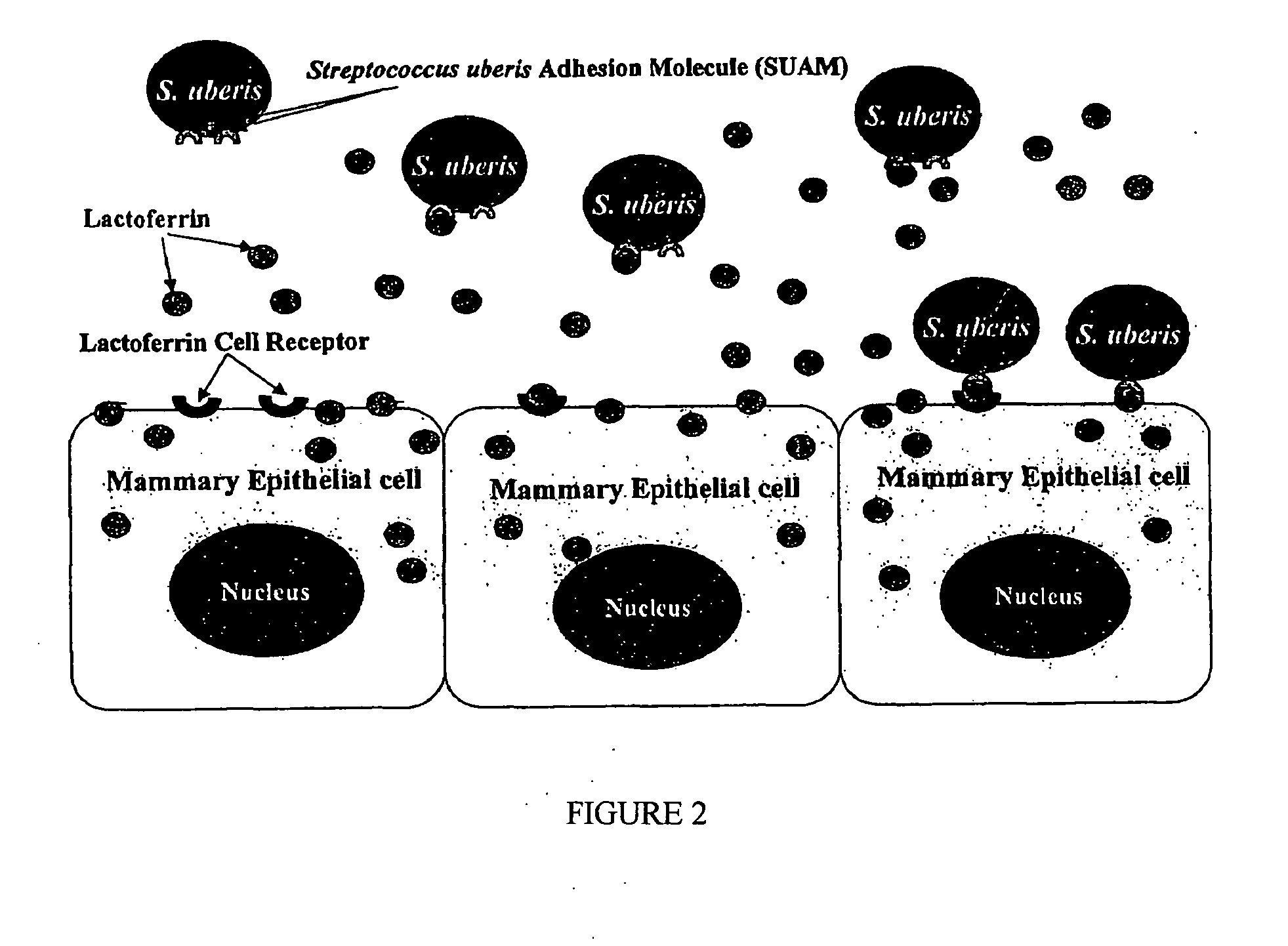Streptococcus uberis adhesion molecule
a technology of streptococcus uberis and adhesion molecules, applied in the field of antigenic proteins and polypeptides, can solve the problems of permanent loss of dairy cattle production, affecting the production efficiency of dairy cattle, and reducing milk production and composition
- Summary
- Abstract
- Description
- Claims
- Application Information
AI Technical Summary
Benefits of technology
Problems solved by technology
Method used
Image
Examples
example 1
[0063]Identification of Streptococcus uberis lactoferrin-binding proteins (prior art), (described in Fang, W., and S. P. Oliver, FEMS Microbiol. Lett. 176:91) (1999)
[0064]Experiments were conducted to examine binding of lactoferrin (LF) by strains of S. uberis causing bovine mastitis and to identify proteins from the bacteria involved in LF-binding. Four strains of S. uberis isolated originally from dairy cows with mastitis and S. uberis ATCC13387 (American Type Culture Collection, Rockville, Md.) were evaluated. After growth, bacterial cultures were washed and split into two equal portions: one for incubation in milk and the other in phosphate buffered saline (PBS) (as controls). Bacterial surface proteins from pellets were extracted using 0.2% sodium dodecyl sulfate (SDS) and electrophoresed. Gels were silver-stained or transferred onto nitrocellulose membranes for immunoblotting using rabbit anti-bovine LF antibody and HRP (horseradish peroxidase)-conjugated donkey anti-rabbit Ig...
example 2
[0068]Effect of lactoferrin on adherence of Streptococcus uberis to bovine mammary epithelial cells (prior art) (described in Fang, W., R. A. Almeida, and S. P. Oliver, Am. J. Vet. Res. 61:275) (2000)
[0069]A series of experiments were conducted to determine effects of LF on adherence of S. uberis to mammary epithelial cells. Three strains of S. uberis were used. In the first experiment, we investigated the effect of LF on adherence of S. uberis to bovine mammary epithelial cells. Sterile LF in Dulbecco's Modified Eagle Medium (DMEM) or milk (0.5 ml) and 0.5 ml of bacterial suspension containing 1-2×108 cfu / ml in DMEM were added to bovine mammary epithelial cell line (MAC-T) monolayers. Final concentrations for LF were 0, 0.01, 0.1 and 1 mg / ml. Those for milk were 0, 12.5%, 25% and 50%. Bacteria were allowed to adhere to MAC-T cells and supernatants were then aspirated and diluted for bacterial counting. Monolayers were washed and lysed, and cell lysates were 10-fold diluted for bact...
example 3
Investigation of Influence of Strain of S. uberis on the Enhancing Effect of LF on Adherence and Internalization to Mammary Epithelial Cells
[0074]To further investigate a possible strain influence on the enhancing effect of LF on adherence and internalization to mammary epithelial cells, additional studies were conducted. In these studies, six strains of S. uberis isolated originally from milk of dairy cows with mastitis were used. Bacteria were pretreated with LF (ICN, Aurora, Ohio), 21.4% iron saturation and 97.5% protein content, 1 mg / ml) for 1 h at 37° C., washed 3 times with PBS (pH 7.4), resuspended in DMEM and cocultured with MAC-T cells for 1 h. After incubation, supernatants were removed, monolayers were washed and either lysed with trypsin / triton solution to determine total cell associated bacteria or treated with antibiotic solution to determine internalization of bacteria into mammary epithelial cells. For the latter, after 2 h of incubation, antibiotic solution was remo...
PUM
| Property | Measurement | Unit |
|---|---|---|
| molecular weight | aaaaa | aaaaa |
| pH | aaaaa | aaaaa |
| pH | aaaaa | aaaaa |
Abstract
Description
Claims
Application Information
 Login to View More
Login to View More - R&D
- Intellectual Property
- Life Sciences
- Materials
- Tech Scout
- Unparalleled Data Quality
- Higher Quality Content
- 60% Fewer Hallucinations
Browse by: Latest US Patents, China's latest patents, Technical Efficacy Thesaurus, Application Domain, Technology Topic, Popular Technical Reports.
© 2025 PatSnap. All rights reserved.Legal|Privacy policy|Modern Slavery Act Transparency Statement|Sitemap|About US| Contact US: help@patsnap.com



